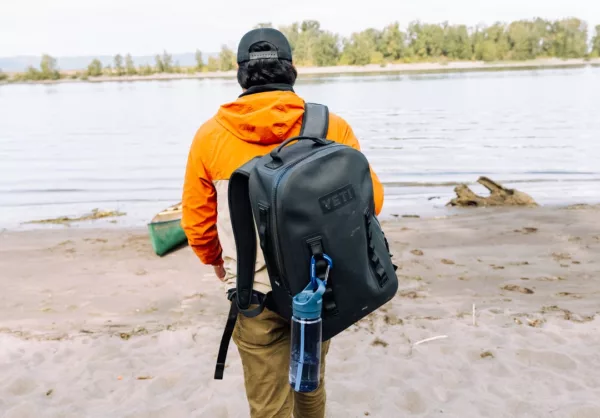How to Properly Store Your Winter Gear

Come the end of ski season, most of us haphazardly toss our gear in the garage or closet, thinking we’ll deal with it later. But the next thing we know, it’s winter again and our skis still have that film of dirt from last season. Our gear, especially because we’ve spent so much on it, deserves better than that. Here’s how to properly care for skis, boards, boots and clothes so we can maximize their lifespan and keep them in tip-top shape from season to season.
Storing Skis and Snowboards
 Vivian Chung
Vivian Chung
Putting these gear items away at the end of the season requires more work than, say, stashing away your holiday decorations. But a few tedious tasks will be worth the payoff when your gear continues to stay in good shape and is pristine and ready to go once the snow falls again.
Prep your snowboard for storage by unmounting the bindings so you can properly check for any nicks and scuffs. Wipe down the board, along with the bindings and screws, to remove any grime and moisture. Storing the board without the bindings will help keep the shape of the board. Put the screws in a small plastic bag and tape it to the board. Sharpen the edges of your board and skis to prevent rusting over the off-season, focusing on any uneven areas. To keep the base protected, give your board a generous layer of wax, making sure not to scrape it off after it cools.
Though the shed in the backyard or your garage may seem like obvious places to store bulky sports equipment, they’re generally prone to extreme swings in temperature, which can wear down your equipment over time. Extreme coldness can crack your board while extreme heat for prolonged periods can even warp it. Store your equipment in a cool, dry and temperature-controlled space, like in your closet or den. Because sheds and garages are also prone to condensation, any moisture can cause rusting on the edges of your board and skis. Store your equipment upright to minimize the chances of tripping over it, especially in a tight space, and to minimize the chances of things falling on top of it which could damage or warp the shape. Though carry bags are practical for shuttling your skis and board around, store the bag separately to avoid condensation forming on your equipment.
Storing Winter Clothes
 Vivian ChungTo prevent yourself from pulling creased and smelly clothes out of storage at the start of next season, wash your winter clothes according to the labels on the garments. Most of the time, performance shells and ski pants require a technical wash like Nikwax or Grangers to keep the waterproofing capabilities intact. If needed, apply a new coat of DWR (durable water repellent), a finish that boosts water resistance. Repair any holes or snags in your garments to save yourself the hassle next season and let everything dry—hang dry or put it on low heat in the machine, depending on the garment’s label. If your closet space allows, hang your winter clothes in garment bags to keep dust from collecting. Those of us who are short on space can fold jackets and pants loosely and store them in bins. Hard creases can cause the membrane of these garments to weaken over time, so it’s important not to have performance gear packed underneath heavy items.
Vivian ChungTo prevent yourself from pulling creased and smelly clothes out of storage at the start of next season, wash your winter clothes according to the labels on the garments. Most of the time, performance shells and ski pants require a technical wash like Nikwax or Grangers to keep the waterproofing capabilities intact. If needed, apply a new coat of DWR (durable water repellent), a finish that boosts water resistance. Repair any holes or snags in your garments to save yourself the hassle next season and let everything dry—hang dry or put it on low heat in the machine, depending on the garment’s label. If your closet space allows, hang your winter clothes in garment bags to keep dust from collecting. Those of us who are short on space can fold jackets and pants loosely and store them in bins. Hard creases can cause the membrane of these garments to weaken over time, so it’s important not to have performance gear packed underneath heavy items.
Storing Boots and Accessories
 Vivian Chung
Vivian Chung
Prep your ski, snowboard and winter snow boots for storage by removing dirt and debris.
If your ski and snowboard boots allow, remove and hand wash the liner and insoles to prevent odours and bacteria from forming. Hang them on a rack to dry or use a hair or boot dryer before storing them away. Rinse the boot shells with water and get into the ridges of the soles and nooks and crannies of the boot by using a rag or sponge with soapy water. Once they’re dry, buckle them up to keep their shape.
To clean your snow boots, use an agent like Nikwax Footwear Cleaning Gel which can safely be used on a variety of materials like suede, full-grained leather and synthetics. Clean the uppers with a damp cloth and remove the insoles to air them out. Once they’re dry, store them in a dust bag or in a bin, being careful not to place them on top of each other to keep their shape and prevent scuffing.
More in Gear:
Price of Entry: The Cost of Adventure
A Guide to Buying Vegan Outdoor Gear
Do Hiking Socks Really Make a Difference?















